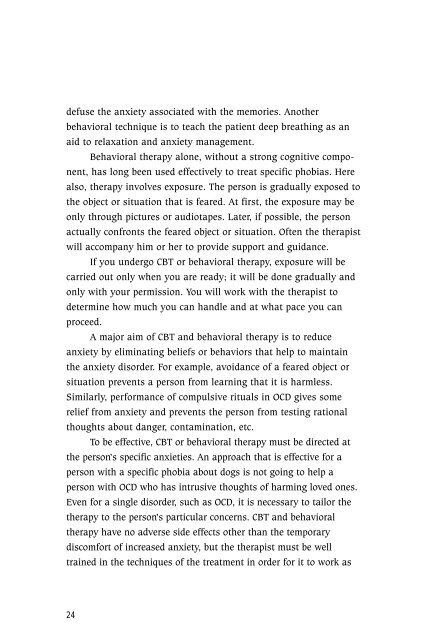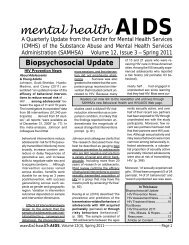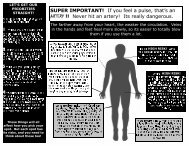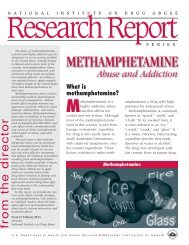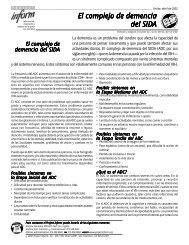Anxiety Disorders - CD8 T cells
Anxiety Disorders - CD8 T cells
Anxiety Disorders - CD8 T cells
You also want an ePaper? Increase the reach of your titles
YUMPU automatically turns print PDFs into web optimized ePapers that Google loves.
defuse the anxiety associated with the memories. Another<br />
behavioral technique is to teach the patient deep breathing as an<br />
aid to relaxation and anxiety management.<br />
Behavioral therapy alone, without a strong cognitive component,<br />
has long been used effectively to treat specific phobias. Here<br />
also, therapy involves exposure. The person is gradually exposed to<br />
the object or situation that is feared. At first, the exposure may be<br />
only through pictures or audiotapes. Later, if possible, the person<br />
actually confronts the feared object or situation. Often the therapist<br />
will accompany him or her to provide support and guidance.<br />
If you undergo CBT or behavioral therapy, exposure will be<br />
carried out only when you are ready; it will be done gradually and<br />
only with your permission. You will work with the therapist to<br />
determine how much you can handle and at what pace you can<br />
proceed.<br />
A major aim of CBT and behavioral therapy is to reduce<br />
anxiety by eliminating beliefs or behaviors that help to maintain<br />
the anxiety disorder. For example, avoidance of a feared object or<br />
situation prevents a person from learning that it is harmless.<br />
Similarly, performance of compulsive rituals in OCD gives some<br />
relief from anxiety and prevents the person from testing rational<br />
thoughts about danger, contamination, etc.<br />
To be effective, CBT or behavioral therapy must be directed at<br />
the person’s specific anxieties. An approach that is effective for a<br />
person with a specific phobia about dogs is not going to help a<br />
person with OCD who has intrusive thoughts of harming loved ones.<br />
Even for a single disorder, such as OCD, it is necessary to tailor the<br />
therapy to the person’s particular concerns. CBT and behavioral<br />
therapy have no adverse side effects other than the temporary<br />
discomfort of increased anxiety, but the therapist must be well<br />
trained in the techniques of the treatment in order for it to work as<br />
24


